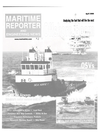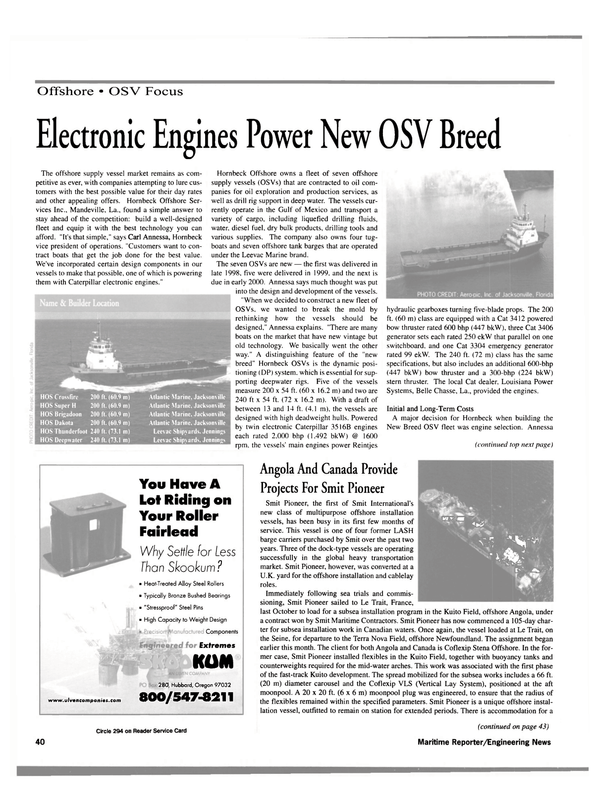
Electronic Engines Power New OSV Breed
The offshore supply vessel market remains as competitive as ever, with companies attempting to lure customers with the best possible value for their day rates and other appealing offers. Hornbeck Offshore Services Inc., Mandeville, La., found a simple answer to stay ahead of the competition: build a well-designed fleet and equip it with the best technology you can afford. "It's that simple," says Carl Annessa, Hornbeck vice president of operations. "Customers want to contract boats that get the job done for the best value.
We've incorporated certain design components in our vessels to make that possible, one of which is powering them with Caterpillar electronic engines." Hornbeck Offshore owns a fleet of seven offshore supply vessels (OSVs) that are contracted to oil companies for oil exploration and production services, as well as drill rig support in deep water. The vessels currently operate in the Gulf of Mexico and transport a variety of cargo, including liquefied drilling fluids, water, diesel fuel, dry bulk products, drilling tools and various supplies. The company also owns four tugboats and seven offshore tank barges that are operated under the Leevac Marine brand.
The seven OSVs are new — the first was delivered in late 1998, five were delivered in 1999, and the next is due in early 2000. Annessa says much thought was put into the design and development of the vessels.
"When we decided to construct a new fleet of OSVs, we wanted to break the mold by rethinking how the vessels should be designed," Annessa explains. "There are many boats on the market that have new vintage but old technology. We basically went the other way." A distinguishing feature of the "new breed" Hornbeck OSVs is the dynamic positioning (DP) system, which is essential for supporting deepwater rigs. Five of the vessels measure 200 x 54 ft. (60 x 16.2 m) and two are 240 ft x 54 ft. (72 x 16.2 m). With a draft of between 13 and 14 ft. (4.1 m), the vessels are designed with high deadweight hulls. Powered by twin electronic Caterpillar 3516B engines each rated 2.000 bhp (1.492 bkW) @ 1600 rpm, the vessels' main engines power Reintjes hydraulic gearboxes turning five-blade props. The 200 ft. (60 m) class are equipped with a Cat 3412 powered bow thruster rated 600 bhp (447 bkW), three Cat 3406 generator sets each rated 250 ekW that parallel on one switchboard, and one Cat 3304 emergency generator rated 99 ekW. The 240 ft. (72 m) class has the same specifications, but also includes an additional 600-bhp (447 bkW) bow thruster and a 300-bhp (224 bkW) stern thruster. The local Cat dealer, Louisiana Power Systems, Belle Chasse, La., provided the engines.
Initial and Long-Term Costs A major decision for Hornbeck when building the New Breed OSV fleet was engine selection. Annessa says that Caterpillar main and auxiliary engines figured prominently into the process when considering initial investment, ownership cost and technology.
"The Cat engines were a logical choice from every standpoint," he explains. "The initial cost of the 3516B engine is extremely competitive. Its compact size makes it easy to install in a smaller place, which allows for more cargo storage. Many competitive engines require purchasing lots of extra equipment during installation; with Cat, it's a complete package." To determine the engine with the best lube oil and fuel consumption, Hornbeck conducted life cycle analyses between the Cat 3516 engine and a competitive engine. The results impressed Annessa: Total fuel consumption per vessel has averaged between 40 to 60 gallons (151 and 227 L) per running hour with the Cat engines, about onehalf the consumption of vessels fitted with the competitive engine. Lube oil costs per horsepower were lower as well. And because these costs are passed on to the customer, Annessa says, it's to Hornbeck's advantage to keep them as low as possible.
With many competitive OSVs powered by conventional mechanical diesel engines, Annessa found that electronic controls were another key benefit to the Cat engines. "There's a great deal of emphasis on tradition in this industry.
It's difficult to change what people are comfortable with - they like what they know works. But I'm more comfortable with the monitoring and diagnostic capabilities of electronic engines. They alert us if there's a problem, and the built-in safeguards can limit engine damage in high load situations." The engines also produce minimal smoke — a benefit Annessa finds useful with current and pending emissions regulations.
Overall, Annessa is pleased with the New Breed fleet and believes his customers are, too. "Our goal is to provide a high level of service at high value to the client. We give it to them by contracting professionally crewed, wellbuilt, reliable boats, and the Cat engines have greatly contributed to that." Circle 114 on Reader Service Card
Read Electronic Engines Power New OSV Breed in Pdf, Flash or Html5 edition of April 2000 Maritime Reporter
Other stories from April 2000 issue
Content
- Corsaire 13000 Embodies Integrated, Advanced Propulsion System page: 48D
- Jotun: Greening the trade in crude page: 8
- Financing Sources for U.S. Government Programs page: 14
- Deltamarin And Almaco Join Together page: 18
- ASRY Reports Prosperous 1999 page: 18
- A New View page: 20
- The Smokeless Solution Is Coming Over The Horizon page: 22
- Strategic Value Adding Purchasing page: 28
- DCR Optimistic About Future Of Offshore Drilling Sector page: 34
- Offshore Industry Leaders Invest Heavily In Safety Programs page: 36
- Electronic Engines Power New OSV Breed page: 40
- Angola And Canada Provide Projects For Smit Pioneer page: 40
- Rig Repowered At Houston Ship Repair page: 41
- Charting The World Electronically page: 44
- Reality Checked page: 45
- NoFire Technologies Helps Ships Meet SOLAS page: 48
- Is Diesel-Electric Propulsion the System for You? page: 50
- Drew Marine, MAN B&W Launch Redesigned Fuel Mill page: 52
- Austal Breaks 24-Hour Record page: 53
- PropExpert V. 4.2 Released page: 53
- GE To Supply Gas Turbines For IHI page: 54
- Jabsco Offers Oil Change Kit page: 54
- Calling All Mariners page: 56
- MTN, BT Hook-Up Cruise Ships To Cell Phone Network page: 59
- Norwegian Manufacturers Maintain Edge page: 60
- Leica Extends Its Influence In DGPS Arena page: 69
- ViaSat Ups Phase Two page: 69
- Encouraging best practice onboard using video and interactive media page: 73
- Blount Completes Dinner Vessel page: 74
- ACCL Offers New Chicago-Based Cruises page: 78
- Boatracs To Exclusively Distribute MarStar page: 78
- DNV Cleans Up With Celebrity's Millennium page: 79
- Transas Unveils GMDSS Simulator page: 85


